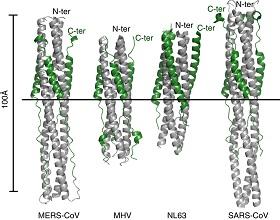Using AI to control energy for indoor agriculture
30 September 2024
Published online 26 February 2014

A team of researchers have designed a peptide which would hinder the entry of the Middle East Respiratory Syndrome Coronavirus (MERS-CoV) into host cells, Nature Communications has reported.
The virus, which probably originates in camels, has a fatality rate of up to 42% and scientists are scrambling to find a way to halt its transmission.
Recently, a team of researchers in China and the United States crystallized a subunit of the protein that MERS-CoV uses to adhere to and enter its host cells, and solved its three-dimensional structure. They used the structure as a template to design peptides that bind and inhibit this membrane fusion protein, thereby interfering with the entry of the virus into its host cells.
"There aren't any specific anti-MERS-CoV drugs currently on the market," says Shibo Jiang, molecular virologist at the Institute of Medical Microbiology, Fudan University, China, and one of the authors of the study. "Some non-specific antiviral drugs, such as ribavirin and interferon-alpha2b, have been used in clinics for treating MERS-CoV-infected patients. But their efficacy has not been confirmed."
The team believes that the peptides they designed have the potential to be developed into drugs that are less toxic and more effective in combatting MERS-CoV.
MERS-COV was first reported in Saudi Arabia in 2012 with first evidence of the virus found in camels. Like many viruses, the MERS-CoV viral particle is made up of an RNA genome wrapped in a protein coat, which in turn is enclosed in a lipid envelope. Protein protrusions through the lipid envelope, known as spikes, bind receptors on the host cell surface, and this binding mediates the fusion of the viral lipid envelope with the host cell lipid membrane and the subsequent entry of the virus into the host cell.
None of the pharmaceutical companies we approached is interested in the development of any anti-MERS-CoV drugs.
With a high structural similarity to SARS-CoV, an outbreak of which in 2002-2003 killed more than 700 people, MERS-CoV has a spike protein (S), made up of two subunits; S1 and S2. Host cell binding occurs through an interaction between the receptor-binding domain in the S1 subunit and its host cell receptor, dipeptidyl peptidase-4 (DPP4).
The team hypothesized that following this binding with S1, S2 changes its conformation by inserting a part of its sequence, called the fusion peptide, into the host membrane, resulting in the formation of a six-helix bundle structure – the fusion core – in the host cell membrane between two regions in the S2 subunit known as the Heptad Repeats 1 and 2 (HR1 and HR2).
To test this hypothesis, they created a protein made up of only HR1 and HR2 to simulate an isolated fusion core, crystallized it, and investigated its structure to see whether it would actually form a six-helix bundle. As expected, they found a six-helix bundle fusion core and used the solved structure to design peptides to bind and inhibit the HR1 and HR2 domains. Tests revealed one peptide had particular efficacy.
The next step, Jiang says, is to carry out preclinical trials in animal models such as monkeys as soon as possible, followed by clinical trials. "But unfortunately," says Jiang "none of the pharmaceutical companies we approached is interested in the development of any anti-MERS-CoV drugs, because of the unpredictable market in the future."
His lab developed anti-SARS-CoV peptides in 2003, but as control was gained over the epidemic, pharmaceutical companies lost interest in developing cures.
Matthew Frieman, of the University of Maryland School of Medicine, a world expert in the microbiology and immunology of SARS, said: "The continued identification of novel therapeutics for MERS-CoV is a worthwhile endeavor due to the unknown nature of its future spread.
"The development of novel treatment strategies, be it peptide, antibody, vaccine or drug based is a worthy investment."
doi:10.1038/nmiddleeast.2014.55
Stay connected: